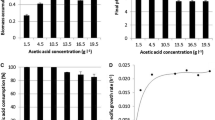Summary
-
(1)
In D-sorbitol media fermented byAcetobacter suboxydans orAcetobacter melanogenum, two reducing sugars, not. previously described, were found as side-products in addition to L-sorbose. In D-mannitol media fermented in the same way, one other reducing sugar not previously described was found in addition to D-fructose.
-
(2)
These secondary metabolites were isolated. From their behaviour in paper chromatography and the drop reaction it was concluded that the secondary metabolite of biochemical dehydrogenanation of sorbitol with a RF of 0.52 in development in a water-saturated phenol system was D-fructose and that the other secondary metabolite of biochemical dehydrogenation of sorbitol, which in this system had a BF of 0.29, was not identical with any of the usual sugars, but was identical with the secondary metabolite of biochemical dehydrogenation of D-mannitol.
-
(3)
On the basis of the conditions of formation of this other metabolite is was concluded, in agreement with previous findings in the literature, that it was 5-keto-L-sorbose (5-keto-D-fructose).
Abstract
-
(1)
На D-сорбитовых средах, сбраживаемых бактериями Acetobacter suboxydans или Acetobacter melanogenum, были — кроме L-сорбозы — найденыв качестве побочных продуктов еще два до сих пор не описанных восстанавливающих сахара; при таком же сбраживании D-маннита быи обнаружен — кроме D-фруктозы — еще один до сих пор не описанный восстанавливающий сахар.
-
(2)
Эти побочные метаболиты были выделены. Из их поведения при хроматографии на бумаге и из результатов капельных реакций вытекает, что побочным метаболитом биохимической дегидрогенации сорбита, R F котрого при проявлении в системе фенола, насыщенного водой, составляет 0,52, оказывается D-фруктоза и что второй побочный продукт биохимической дегидрогенации сорбита, обладающий в этой системе R F = 0,29, не является тожественным ни с одним из обычно встречающихся сахаров, но тожественным с пегидрогенации D-маннита.
-
(3)
На основе оценки условий возникновения этого второго метаболита и имеющихся до сих пор данных лит ературы было сделано заключение, что речь идет о 5-кето-L-сорбозе (5-кето-D-фруктозе).
Similar content being viewed by others

References
Brown, C. A., Zerban, F. W.:Physical and chemical methods of sugar analysis. John Wiley & Sons, New York 1941.
Cheldelin, V. H., Hauge, J. G., King, T. E.:Oxidative dissimilation in pantothenate-defficent Acetobacter suboxydans cells. Proc. Soc. exp. Biol. Med. 82: 144, 1953.
Cummins, J. T., King, T. E., Cheldelin, V. H.:The biological oxidation of sorbitol. J. biol. Chem. 224 323, 1957.
De Ley, J., Stouthamer, A. J.:The mechanism and localization of hexonate metabolism in Acetobacter suboxydans and Acetobacter melanogenum. Biochim. biophys. Acta 34: 171, 1959.
Fawstor, J. A.:Kinase activity of ultrasonic extracts of Acetobacter suboxydans. Biochem. J. 66: 9P, 1957.
Fewstor, J. A.:Growth of Acetobacter suboxydans and the oxidation of aldoses, related carboxylic acids and aldehydes. Biochem. J. 69: 582, 1958.
Frateur, J., Simonart, P., Coulon, T.:Étude chromatographique de cultures ďAcetobacter. Ant. v. Leeuwenloek Journ. 20: 111, 1954.
Geldmacher-Mallinckrodt, M.:Nachweis und Unterscheidung von Zuckern und Polysacchariden durch empfndliche Tüpfelreaktion auf Seide. Biochem. Z. 324: 186, 1953.
Hais, I. M., Macek, K.:Handbuch der Papierchromatographie, Bd. I, Fischer Verlag, Jena 1958.
Katznelson, H., Tannenbaum, S. W., Tatum, E. L.:Glucose, gluconate and 2-ketogluconate oxidation by Acetobacter melanogenum. J. biol. Chem. 204: 43, 1953.
King, T. E., Cheldelin, V. H.:Phosphorylative and nonphosphorylative oxidation in Acetobacter suboxydans. J. biol. Chem. 198: 135, 1952.
King, T. E., Cheldelin, V. H.:Oxidative dissimilation of nonnitrogenous compounds in Acetobacter suboxydans. Science 115: 14, 1952.
King, T. E., Cheldelin, V. H.:Sources of energy and the dinitrophenol effect in the growth of Acetobacter suboxydans. J. Bactoriol. 60: 581, 1953.
Kulhánek, M.:Biochemické dehydrogenace aldonových kyselin I. Biochemické dehydrogenace kyselin hexonových bakteriί Pseudomonas aeruginosa. Chem. listy 47: 1071, 1953a. Ref.: C. A. 48: 4043, 1954.
Kulhánek, M.:Biochemické dehydrogenace aldonových kyselin III. Vztah mezi konfiguracί aldonovίch kyselin a jejich dehydrogenovatelnostί. Chem. listy 47: 1081, l953b. Ref.: C. A. 48: 4044, 1954.
Liebster, J., Lukšίk, B., Färber, G., Svoboda, V.:Nová metoda isolace dihydroacetonu a L-sorbosy z kvasnίch substrátů. Chem. listy 50: 395, 1956.
Micheel, F., Horn, K.:Über eine vergärbare Di-ketose, die 5-ketofructose (5-Fructonose). Ann. 515: 1, 1935.
Regna, P. P.:5-Desoxy-L-sorbose. J. Amer. chem. Soc. 69: 246, 1947.
Riiber, C. N., Sörensen, T., Thorkelsen, K.:Lösungs kurven und Refraktionskonstante einiger mehrwehrtigen Alkohole. Ber. 58: 964, 1925.
Terada, O., Tomizawa, K., Kinoshita, S.:Formation of 5-dehydrofructose by members of Acetobacter sp. Part I.Formation of a new strong reducing substance from fructose and its discrimination from. glucosone. Nippon Nogeikagu Kaishi 35: 127, 1961a. Ref.: Agr. Biol. Chem. (Japan) 25: A15,. 1961.
Terada, O., Tomizawa, K., Suzuki, S., Kinoshita, S.:Formation of 5-dehydrofructose by Acetobacter sp. Part II. On the fermentation, purification and properties of crystal. Nippon Nogeikagaku Kaishi 35: 131, 1961b. Ref.: Agr. Biol. Chem. (Japan) 25:A l6, 1961.
Author information
Authors and Affiliations
Additional information
Papers I-III, on “Biochemical dehydrogenation of aldonic acid”, are published in Chemické listy 47 : 1071-1085, 1953.
Presented at the conference on “The utilization of the biochemistry of microorganisms in the fermentation industry”, Smolenice, May 1961
Rights and permissions
About this article
Cite this article
Kulhánek, M., Ševčίková, Z., Кулъеанек, М. et al. Biochemical dehydrogenation of saccharides IV. Secondary products of biochemical dehydrogenation of D-sorbitol and D-mannitol. Folia Microbiol 7, 288–297 (1962). https://doi.org/10.1007/BF02928658
Revised:
Issue Date:
DOI: https://doi.org/10.1007/BF02928658



